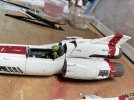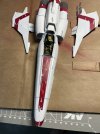I had a progress post, but I am reposting to get some advice. This was an experiment with using liquid mask for chipping. I do not like how it turned out. So do I touch up, paint over, or strip and start again?
I would love advice on stripping. It (bottom layer to top). Vallejo polyurethane primer, light grey model air coat, white model air coat, a coat of AK interactive's intermediate gauzy agent, then the red paint. All paint is water based acrylic.
Thanks!


I would love advice on stripping. It (bottom layer to top). Vallejo polyurethane primer, light grey model air coat, white model air coat, a coat of AK interactive's intermediate gauzy agent, then the red paint. All paint is water based acrylic.
Thanks!


